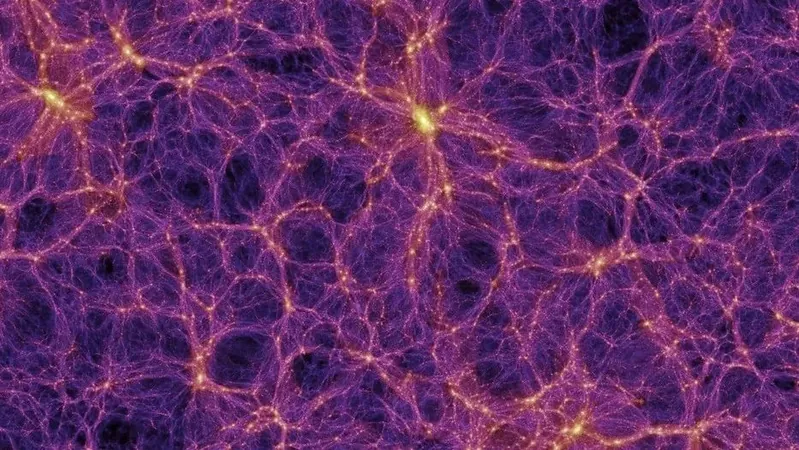
Unlocking the Secrets of Dark Matter: The Cosmic Web's Superhighways Revealed!
2024-11-20
Author: Wei
Imagine the universe as a vast, intricate spider web, with colossal filaments connecting clusters of galaxies, reminiscent of superhighways weaving between cities. This cosmic web is the largest structure in nature, holding crucial secrets about the universe's past and its mysterious contents, particularly dark matter and dark energy. Despite their significance, accurately measuring the mass of these filaments has proven to be a daunting endeavor—a challenge that researchers are now starting to overcome.
Recent developments in astrophysical research have unveiled a novel method for quantifying the mass of these cosmic filaments. The ability to measure their mass could ultimately shed light on the enigma of dark matter—a substance that constitutes about 27% of the universe yet remains invisible to us. The filaments, far from being static structures, play a dynamic role, embodying the interconnectedness of galaxy clusters and showcasing the ongoing evolution of the universe.
Spanning tens of millions of light-years and harboring hundreds of thousands of galaxies, these filaments serve as the backbone of superclusters. They emerged over 13 billion years ago during the universe's infancy, a time when the first stars and galaxies ignited. Understanding the current architecture of the cosmic web offers insights into the evolution of not only visible matter but also elusive components like dark matter and dark energy. Each alteration in these cosmic ingredients can lead to a distinctive configuration of the cosmic web.
For years, astronomers relied on simple statistical analyses of the cosmic web, such as the average distance between galaxies, to glean information about its fundamental constituents. However, the true nature of dark matter and dark energy remains shrouded in mystery, necessitating more detailed investigations into the cosmic web's structure.
The filaments, unlike fully collapsed galaxy clusters, present a unique opportunity for probing dark matter and dark energy. They contain significant material yet are still evolving. Variations in dark matter and dark energy could influence the filaments' average length and density, highlighting their potential for revealing fundamental truths about the universe.
One key challenge, however, lies in measuring filament masses. The majority of their mass is made up of dark matter, invisible to direct observation. Researchers can only map the visible galaxies and use their distribution to infer the hidden mass and structural characteristics of the filaments.
In an exciting paper soon to be published in *The Astrophysical Journal*, scientists have proposed an innovative approach to tackle this challenge. By utilizing cosmological simulations that trace the evolution of dark matter alongside stars and galaxies, they discovered a meaningful correlation between 'redshift dispersion' of galaxies—essentially the spread in their velocities—and the underlying dark matter mass within filaments.
As galaxies drift away from us in our ever-expanding universe, they exhibit local motions influenced by their gravitational surroundings. Consequently, some galaxies within a filament may be moving toward us, appearing blue-shifted, while others recede, resulting in redshift. By analyzing these velocity distributions, researchers have established a method that links this data to the filament's dark matter mass, allowing them to reconstruct it based only on observable parameters.
This groundbreaking work is just the beginning. The researchers plan to refine their method further by exploring the relationship between galaxy velocities and dark matter mass and conducting simulations to see how these dynamics alter in different cosmic scenarios. Eventually, they aim to apply this technique to actual galaxy surveys, revealing even deeper insights into the vast, uncharted territories of our universe.
Stay tuned, as this research could revolutionize our understanding of the cosmic web and the profound mysteries of dark matter that lie hidden just beyond our reach!





 Brasil (PT)
Brasil (PT)
 Canada (EN)
Canada (EN)
 Chile (ES)
Chile (ES)
 España (ES)
España (ES)
 France (FR)
France (FR)
 Hong Kong (EN)
Hong Kong (EN)
 Italia (IT)
Italia (IT)
 日本 (JA)
日本 (JA)
 Magyarország (HU)
Magyarország (HU)
 Norge (NO)
Norge (NO)
 Polska (PL)
Polska (PL)
 Schweiz (DE)
Schweiz (DE)
 Singapore (EN)
Singapore (EN)
 Sverige (SV)
Sverige (SV)
 Suomi (FI)
Suomi (FI)
 Türkiye (TR)
Türkiye (TR)